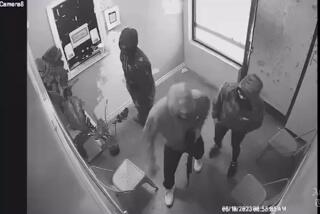Unmasking the Home Invaders
They are the types of violent break-ins that often leave police confounded and victims with lasting scars.
Home-invasion robbers strike fast, preying on both rich and poor, during daylight as well as after dark. Victims often refuse to report the crimes for fear of reprisals or mistrust of police.
Now Orange County is launching a first-of-its-kind study that seeks to enter the minds of bandits who specialize in the violent raids.
Researchers will team up with detectives to tour the country and interview convicted robbers as well as their victims. They hope to better understand how criminals pick their targets and plan their escape.
The study comes on the heels of a spate of violent break-ins in Orange County in which thieves have shot, beaten and tortured victims before making off with thousands of dollars of valuables.
The flurry of robberies has alarmed detectives, who said the number of home-invasion attacks had been slowly declining in recent years. No one tracks reports of such attacks, but district attorney officials say there are about 50 each year and possibly three times as many go unreported.
The violent break-ins first appeared in Vancouver, Canada, during the mid-1970s. A decade later, similar attacks were reported in Southern California, mostly in communities with Asian immigrants.
The crimes became a hallmark of Asian gangs, who preyed on their communities.
Bandits did not discriminate between rich and poor. Their targets included wealthy businessmen, illegal bookmakers and recent immigrants, who were believed to keep their valuables at home.
Over the years, police reported that criminals across the nation and of all ethnicities were increasingly adopting the unique robbery method.
In the last year or so, the robberies have been reported in Chicago, New York, Nebraska and Arkansas, said John Wang, an associate criminal justice professor at Cal State Long Beach.
Wang, who is spearheading the new study, said neither academics nor law-enforcement officials have written much about home invasions.
“There is a need . . . to understand more about this because right now it’s spreading nationwide,” Wang said.
Besides interviewing robbers, the research team will also focus on victims left with a sense of violation after being attacked in their homes.
It’s been seven years since robbers burst into Se Touch’s Santa Ana apartment.
“If you don’t remember, you don’t get afraid,” said Touch, a 67-year-old Cambodian immigrant who came to the United States in 1982 with his family. “I want to move on with my life.”
Touch’s ordeal began about 8 p.m. on July 14, 1994, when his 11-year-old daughter answered the door to a man holding a package. He said he was delivering a gift sent by a relative. Within seconds, several men burst into the one-bedroom apartment, demanding money and forcing Touch’s wife, Lap Ko, and five children, ages 2 to 11, on the floor. Touch was returning home from a nearby market. Just as he opened the door, a gunman pulled him inside, tied a towel around his eyes and knocked him in the head with a gun.
Touch lay unconscious as the robbers ransacked his house, lifting mattresses in search of money, digging in the kitchen pantry, sifting through closets and combing through the sofa and freezer.
The robbers fled but not before snatching the keys to Touch’s Mercedes, taking a stash of jackets and other clothes, and yanking gold necklaces from his sons.
Touch said his family is reminded of that night whenever they hear a knock at the door, noise on the street or rustling in the front yard.
They moved out of the apartment and into a new home surrounded by a security fence. They also bought an 80-pound German shepherd mix, Muscle, to feel safe.
“I am still living in fear,” Ko said. “I can’t live freely anymore.”
Touch and Ko immediately reported the robbery to police.
But detectives investigating home-invasion robberies said one of their biggest obstacles is a lack of cooperation from victims, particularly Asian immigrants, whose language barriers and mistrust of police make them less likely to come forward.
County officials hope that academic researchers will stand a better chance of overcoming those problems.
The study is the brainchild of investigators assigned to a special district attorney’s unit that targets roving gangs--many of whom specialize in home invasions. The unit won a federal grant for the study and for projects on identity theft and drug trafficking, at a total cost of $200,000.
Among the most important parts of the study, officials said, will be a look at the way police nationwide try to curtail the crimes. Officials hope the study will help police and prosecutors determine what works and what doesn’t.
District attorney investigators have also launched a toll-free hotline for victims of home-invasion robberies or tipsters. Call: (866) 230-7580.
More to Read
Sign up for Essential California
The most important California stories and recommendations in your inbox every morning.
You may occasionally receive promotional content from the Los Angeles Times.










